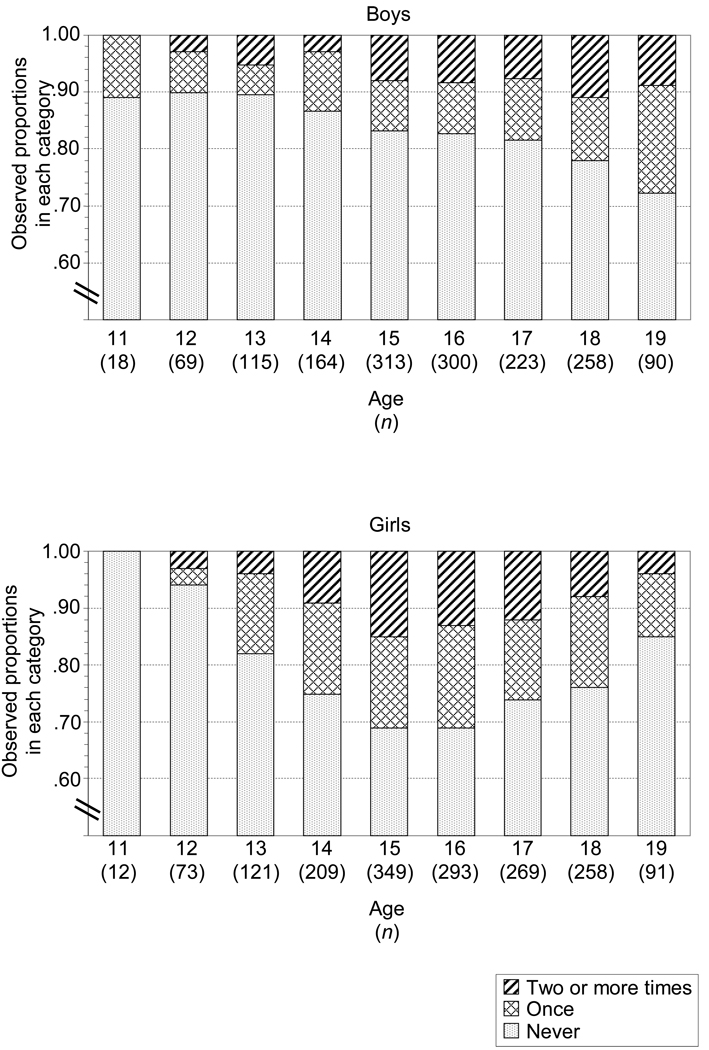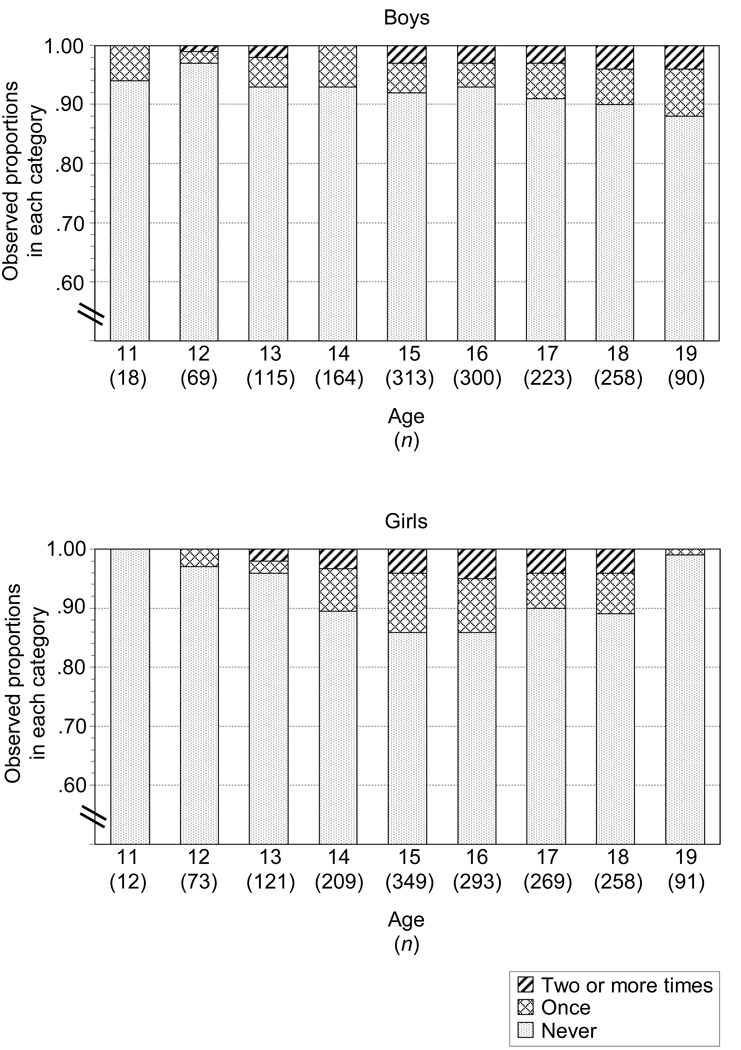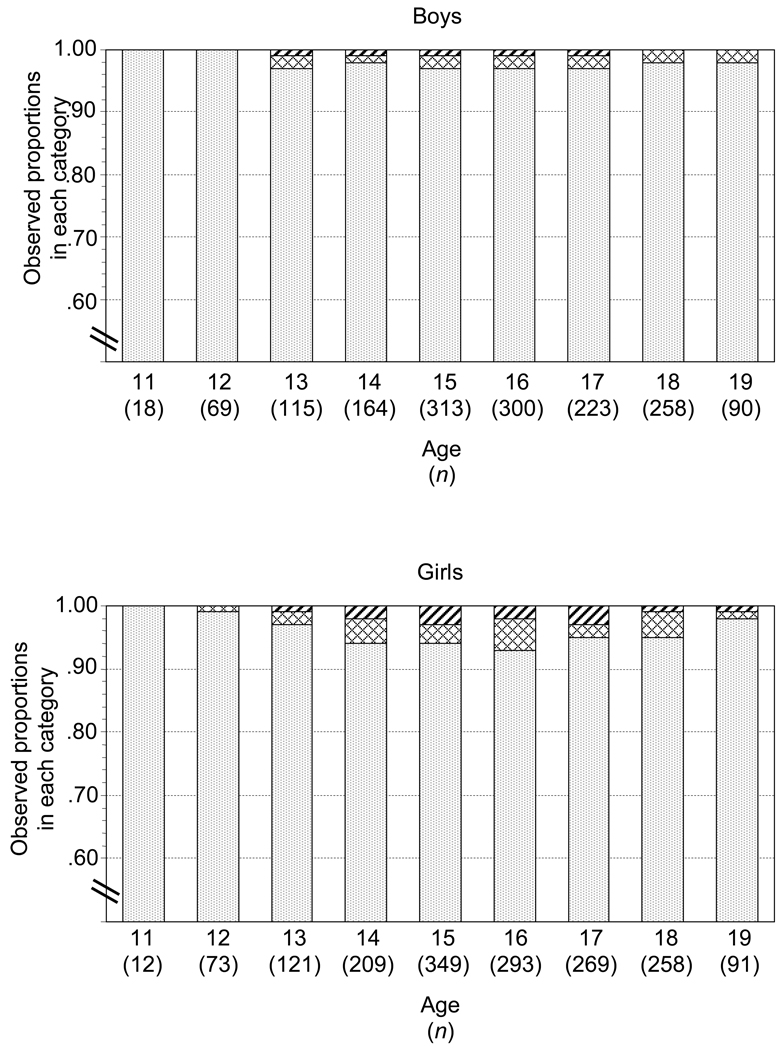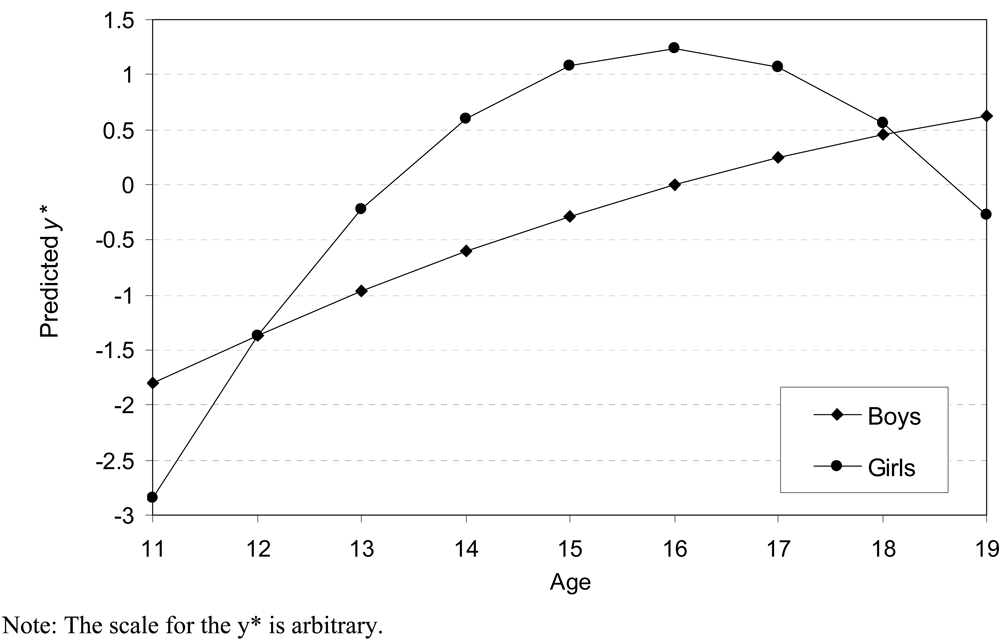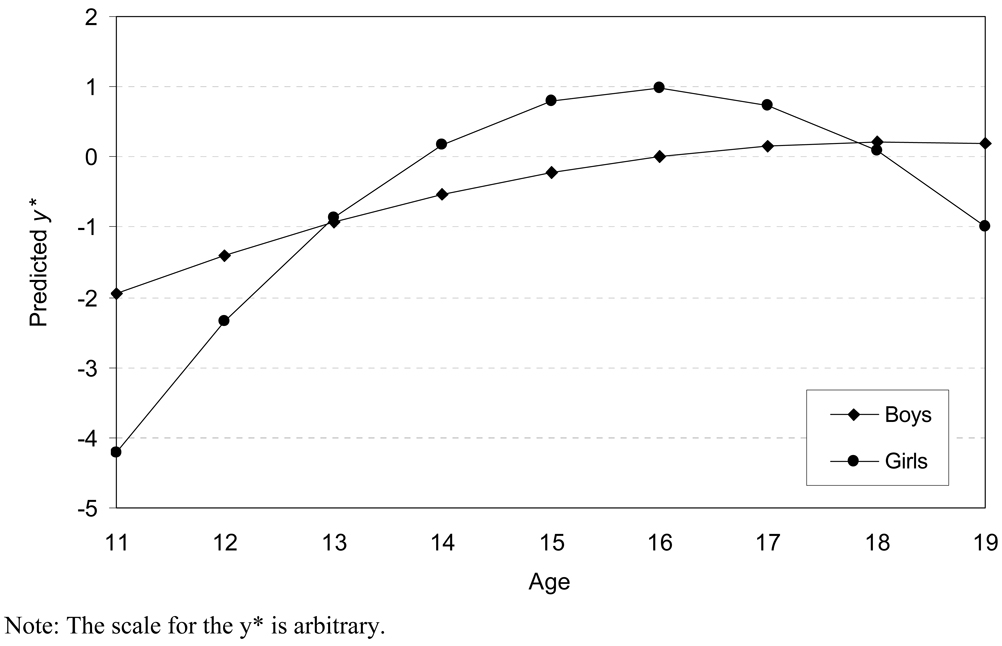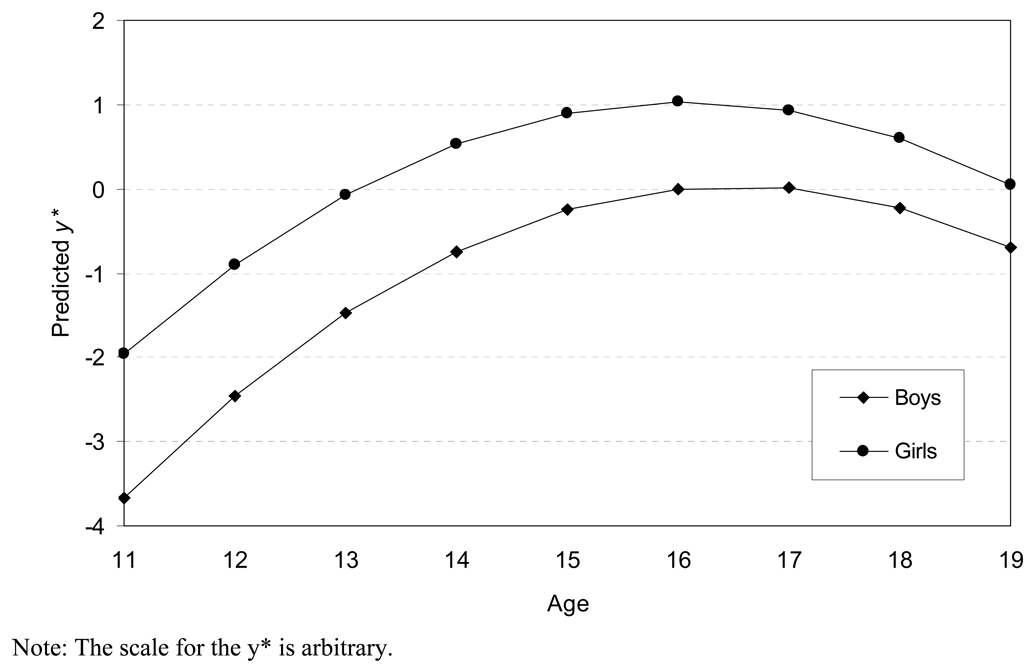Abstract
Although suicide ideation, plans, and attempts increase during adolescence, it remains unclear whether boys’ and girls’ risk for these outcomes peaks at different ages. We used longitudinal categorical data (never, once, 2+ times) from the Family Transitions Project (N = 1248 rural European Americans ages 11–19) to investigate whether yearly prevalence rates of adolescent suicidal episodes follow different patterns by sex. Multiple-group growth models revealed that peak levels of past-year ideation and plans occurred during mid adolescence for girls, but slowly increased through late adolescence for boys. We found that prevalence patterns for attempts were very similar for boys and girls, with both increasing through mid adolescence and then declining, although girls’ risk declined slightly more rapidly. This information may help alert gatekeepers to developmental periods during which boys and girls are particularly vulnerable to suicide-related experiences, and also may help inform the timing of preventive efforts.
Keywords: adolescent suicidality, sex differences, age differences
Youth suicide constitutes a recognized public health concern (Institute of Medicine [IOM], 2002). Treatment and prevention efforts often target suicidal ideation, plans, and attempts, since these thoughts, feelings, and behaviors predict completed suicide and themselves signify intense suffering. Suicidal crises are also the most common precipitants to psychiatric hospitalization (IOM, 2002). Further, adolescent suicidal episodes predict psychiatric disorders and diminished functioning in the realms of work, education, and social relationships during young adulthood (Fergusson et al., 2005; Reinherz et al., 2006). Suicidal ideation, plans, and attempts among adolescents therefore deserve attention as serious mental health outcomes, and consequently constitute the focus of this study.
We investigate the yearly prevalence patterns of suicidal thoughts and behavior by age among European American adolescent boys and girls. European American adolescent girls and boys have higher rates of completed suicide than do Asian and African American adolescents of both sexes (Centers for Disease Control and Prevention [CDC], 2008), so understanding suicide-related phenomena in this population is important. Although numerous studies have assessed specific associations of adolescent suicidality with age and sex (Kessler, Borges & Walters, 1999; Lester, 1991), we know of no studies investigating whether yearly prevalence rates of nonfatal suicide-related outcomes follow different patterns across adolescence, with girls’ and boys’ levels perhaps peaking at different ages. However, such information may well help inform the timing and targeting of preventive interventions, including gatekeeper training (see IOM, 2002). For example, if risk for one of the sexes were to peak only in late adolescence, rather than in early or mid-adolescence, gatekeeper training and health promotion in post-secondary educational institutions (e.g., Holinger, Offer, Barter, & Bell, 1994) may well take on greater urgency for that group, in particular.
Developmentally, we have reason to suspect that trends in suicidality may differ between girls and boys: pubertal onset occurs earlier for girls, on average, than for boys, and this biological transition can be a time of risk for girls, in particular (Caspi, Lynam, Moffitt, & Silva, 1993; Ge, Conger, & Elder, 2001). Depression carries one of the highest risks of any psychiatric disorder for suicide ideation, plans, and attempts (Kessler, et al. 1999), and rates of depressive symptomology increase more rapidly for girls in early adolescence than for boys (Ge, Lorenz, Conger, Elder, & Simons, 1994; Ge, Natsuaki, & Conger, 2006). On the other hand, conduct disorder is particularly common among suicidal youth (see IOM, 2002), and it appears that antisocial, delinquent behavior increases earlier for adolescent boys than girls (Marmorstein & Iacono, 2005. Based on the weight of risk factors in early adolescence, however, it may be that adolescent girls’ suicidality rates reach their maximum at an earlier age than do boys’ rates.
Inspection of rates of completed adolescent suicide by age and sex in the United States from 1999–2004 reveals that rates increased dramatically from year to year for girls during early adolescence, but then stabilized by about age 16, whereas the rates for boys continued to increase yearly through age 19 (CDC, 2008). It remains unknown whether prevalence patterns of suicide ideation, plans, and attempts by sex follow a similar pattern, however. Two studies have focused on related questions: Lewinsohn and colleagues (2001) investigated the timing of first onset of suicide attempts in a normative sample and found that risk of onset for both boys and girls peaked during mid adolescence. However, young women’s risk precipitously dropped after age 18, whereas young men’s risk only slightly decreased in late adolescence. A cross-sectional population-based study of a depressed sample (Wunderlich, Bronisch, Wittchen, & Carter, 2001) found a greater proportion of attempts (but not ideation) for 14–17 year-old girls relative to boys, and no sex differences in attempts or ideation in late adolescence, suggesting a similar late-adolescent increase or maintenance in attempt risk among males (or, decline in such risk for females). Somewhat in contrast to Wunderlich et al.’s (2001) findings on ideation, a recent study (Rueter, Holm, McGeorge, & Conger, 2008) reports descriptive statistics which suggest that proportions of ideation among males may increase between ages 14 and 17, but decrease for females. Systematic investigation by sex of trajectories of ideation, plans, and attempts from early to late adolescents in a normative population is therefore warranted to gain an accurate picture of developmental patterns of suicidal episodes in this life phase.
Given that many individuals report more than one episode of suicidal thoughts or attempts (Kessler et al., 1999; Lewinsohn, Rohde & Seeley, 1994), we believe examining patterns of such occurrences beyond just first onset plays an important role in understanding adolescent boys’ and girls’ risk for suicidal episodes across adolescence. Every indication from the literature supports the contention that those who experience a suicidal episode more than once carry a higher burden of psychopathology and are at greater risk of future attempts and of completed suicide (for a review, see IOM, 2002). Most studies, due to the sparse data generally available related to suicide-related phenomena, use binary outcome variables (no suicidality vs. some suicidality), which also may obscure important information about the extent of the problem. Investigation of prevalence patterns for suicidal ideation, plans, and attempts irrespective of first onset, and which includes information about whether suicidal episodes were experienced just once, or more than once within the reporting period, may provide important information about normative developmental trends in these serious problems.
The Present Study
This study uses longitudinal data on 1244 European-American target adolescents and their siblings to address the question of whether the prevalence of suicidal thoughts and behaviors peaks at different ages for girls versus boys. We document and compare reported rates of serious suicide ideation, suicide plans, and suicide attempts in the past year for boys and girls between ages 11 and 19. Based on available literature related to this topic (Lewinsohn et al., 2001; Wunderlich et al., 2001), we expected peak prevalence to occur at earlier ages for girls compared to boys.
Information on the prevalence of suicidality has generally focused on the presence versus absence of such outcomes. We wanted to account for experiences of more than one suicidal episode in the past year in our investigation of prevalence patterns, however. We therefore use ordinal regression to model each outcome as categorical (0 = never; 1 = once; 2 = two or more times). This kind of information about developmental trends in suicidal experiences could help alert mental health professionals and gatekeepers to periods during which adolescents may be most vulnerable to risk for suicide, and to whether these periods of vulnerability vary by gender.
Methods
Sample and Design
The present study draws from the 1322 target adolescents and closely-aged siblings from the two samples which constitute the Family Transitions Project (FTP): the Iowa Youth and Families Project (IYFP), a study of 451 rural, nondivorced families that began in 1989 (with yearly interviews from 1989–1992); and the Iowa Single-Parent Project (ISPP), a study of 210 rural, mother-headed families who had experienced divorce within the 2 years prior to study onset in 1991 (yearly interviews from 1991–1993). Families in the IYFP were lower to middle class, with the median income at study onset at $33,399; families in the ISPP were also lower to middle class, with a median income of $21,521. The Family Transitions Project (FTP), initiated in 1994, combined these two projects by matching the target adolescents by grade in 1991 (N = 556, interviewed in 1994, 1995, 1997, and ongoing at two-year intervals). Because these studies focus on families living in rural Iowa, and because almost no racial-ethnic minorities live in rural Iowa, the sample’s racial-ethnic composition was limited to families of European descent.
Approximately 90% of the participants have remained in the study from its inception to the most recent wave of data collection. Seventy-four adolescents who originally participated in the study were dropped from analyses due to missing data on every dependent variable (i.e., they did not participate during the relevant assessment waves or were not within the relevant age range for the pertinent waves). The final sample for this study was therefore 1244 adolescents (48.6% males; 67.6% from intact families; mean age at onset = 15.2 years, range = 11 – 19).
Procedure
The IYFP participants were recruited in 1989 via the seventh-grade classes of 34 public and private schools in eight counties in central Iowa. Families were eligible for the study if a seventh grader had a sibling within 4 years of his or her age and she or he was living with both biological parents. Approximately 78% of eligible families agreed to participate in the first wave of data collection in 1989.
The ISPP participants were first identified via lists of students provided by schools in rural areas of Iowa (excluding university communities and urban areas). Telephone calls were made to mothers who were heads of their households. Fifteen percent of those contacted met the strict criteria for inclusion in the study, which were that the families had a target child in eighth or ninth grade in 1991 with a sibling within 4 years of his or her age, and whose biological parents had divorced within the past 2 years. Of those contacted who were eligible for the study, 99% agreed to participate.
Families completed two interviews (scheduled within two weeks of each other) with a trained interviewer during each year of data collection; each interview lasted for about 2 hours and each participating family member was paid about $10 per hour for his or her time. During the first visit, each family member answered a set of questionnaires regarding demographics, mental and physical health, and marital, family, and peer relationships. The current study will utilize this self-report questionnaire data collected when participants were between ages 11 and 19. The adolescents’ suicidal ideation, plans, and attempts were not assessed until the third year of data collection for two-parent families, and the second year of data collection for the single-parent families; relevant assessments therefore include those in 1991, 1992, and 1994 for adolescents in intact families, and 1992, 1993, and 1994 for those in divorced families. The maximum number of assessments per individual is therefore three.
Measures
Demographics
Mothers reported their children’s birth dates and sex at study onset.
Suicidal thoughts and behavior
Suicidal ideation, plans, and attempts during the past year were assessed via questions taken from the Youth Risk Behavior Survey (see Brener et al., 2004). The series of questions was framed by the statement, "Sometimes people become so unhappy with their lives that they consider suicide.” Ideation was then probed via the question, “In the past 12 months, how many times have you seriously thought about committing suicide?”; plans were asked as, “In the past 12 months, how many times have you made a plan to commit suicide?”; and attempts as, “In the past 12 months, how many times have you attempted suicide?” The response category for each question ranged from 0 (never) to 3 (three or more times). For all analyses, response categories were reduced to 0 (never), 1 (once), and 2 (two or more times) to reliably estimate separate and conditional probabilities for each category.
Analyses
To formally test the hypothesized differences in the timing of peak past-year prevalence for ideation, plans, and attempts between boys and girls, we ran multiple-group ordinal logistic growth models using the Mplus program (Version 5.1; Muthén & Muthén, 1998–2007), with sex as the grouping variable. To establish our base measurement model for suicide-related outcomes, we held all thresholds of the outcome variables equal across boys and girls and across waves. Age was centered at 16. We tested the parallel regression assumption (see Agresti, 2007) and found it consistent with the data. We used the robust maximum likelihood estimator; missing data therefore were handled via the full information maximum likelihood approach (FIML; see Newman, 2003). We also used a sandwich estimator to properly estimate the standard errors, given sibling clustering within families.
With a maximum of three waves of observations on each individual and low response frequencies across individuals for the upper categories of our outcome variables, we could not reliably estimate random effects (i.e., individually-varying effects) of age for the linear or quadratic slope terms. However, we could estimate random effects for the intercept (i.e., individual differences in levels of suicidality at age 16), and could still test our hypotheses related to mean effects of age as far as patterns of growth for boys versus girls. We therefore investigated gender differences in average latent growth trajectories by allowing all growth factor means to vary across the two gender groups.
Results
We found that 30.9% of the boys reported serious suicidal ideation at least once during the 3 waves of assessment compared to 41.2% of the girls. Past-year prevalence of at least one time of serious ideation for the boys was 16.4%, 15.9%, and 21.1% for the successive assessment waves. For girls, the rates were 28.6%, 25.3%, and 22%. Observed proportions of past-year frequency of serious suicidal ideation by age (i.e., collapsed across assessment waves) are plotted in Figure 1 for boys and girls. As expected, girls generally reported more ideation across age than boys, although boys’ prevalence was comparable to that of the girls at age 18, and surpassed girls’ rates at age 19. Regarding our first major research question of whether prevalence of ideation peaks at different ages for boys than girls, inspection of Figure 1 indicated that boys’ rates gradually increased through age 19. In contrast, girls’ prevalence showed a clear negative quadratic (inverted U) pattern, with an increase in mid adolescence and subsequent decline in late adolescence.
Figure 1.
Observed Proportions of Suicide Ideation by Age
We found that 15% of the boys reported having made a suicide plan at least once during the 3 waves of assessment compared to 18.1% of the girls. Past-year prevalence of making at least one suicide plan was 8.7%, 6.7%, and 8.2% for boys for the successive assessment waves. For girls, the past-year prevalence was 12%, 10.5%, and 7.2%. Observed proportions of past-year frequency of suicide plans by age are pictured in Figure 2 for boys and girls. Similar to prevalence patterns of ideation, girls generally reported more plans than boys across age, although boys’ rates surpassed that of girls in late adolescence. As with ideation, boys’ prevalence rates increased gradually through late adolescence, and girls’ rates followed the inverted U pattern, rising through mid adolescence and then falling. Prevalence patterns of suicide plans therefore also appear to peak earlier for girls than for boys.
Figure 2.
Observed Proportions of Suicide Plans by Age
We found that 5.4% of the boys reported having made a suicide attempt at least once during the 3 waves of assessment compared to 10% of the girls. Adolescents reported very few attempts from year to year, although girls’ rates were notably higher than that of the boys. Past-year prevalence of making at least one suicide attempt was 2.1%, 2.5%, and 2.7% for boys for the successive assessment waves. For girls, the rates were 5.9%, 5.5%, and 3.7%. Figure 3 shows proportions of past-year frequency of suicide attempts by age for boys and girls. Although attempts were rare, girls generally reported slightly more attempts during mid adolescence than boys. Unlike ideation and plans, yearly prevalence patterns of attempts for boys showed that the highest rates of reported attempts fell between ages 13 and 17. Girls’ observed past-year prevalence pattern for attempts followed a slight quadratic pattern which mimicked that of ideation and plans and therefore suggests a mid-adolescent peak in risk for suicide attempts for girls.
Figure 3.
Observed Proportions of Suicide Attempts by Age
Although our questions center on the developmental patterns for each of these suicide-related outcomes, all three outcomes are related to each other. To help frame these phenomena in this context, we summarize the first within-wave cross-tabulations between ideation and plans, ideation and attempts, and plans and attempts: At the first wave, 24.5% of those who seriously ideated once in the past year had also made a suicide plan once; of those reporting serious ideation two or more times in the past year, 34.2% made a plan once, and 42.3% made a plan two or more times. A similar pattern emerged for cross-tabulations between ideation and attempts: 7.5% of those reporting ideation once in the past year also reported making one attempt, whereas 14.4% of those reporting serious ideation two or more times attempted once, and 18.9% attempted two or more times. Regarding cross-tabulations between plans and attempts, of those reporting never having planned suicide, .3% made one suicide attempt and .1% made two or more attempts; of those reporting having planned suicide once, 19.5% attempted once and 7.8% attempted two or more times, whereas for those reporting having made a plan two or more times in the past year, 21.3% attempted once and 29.8% attempted two or more times. We therefore, consistent with the literature, see that it is always a definite minority of even those individuals who report some level of ideation who also report plans or attempts, and that reporting having ideated or planned more than once in the past year corresponds with a greater likelihood of also reporting more serious kinds of suicidal episodes. Patterns of cross-tabulations at the other two waves were very similar.
Modeling Age-by-Sex Effects
Ideation
The growth model for serious suicidal ideation indicated that, as expected, the age trends for ideation differed significantly between girls and boys: The (mean) effect of linear age was statistically significant for boys and nonsignificant (i.e., not different from 0) for girls, whereas the quadratic age effect was statistically nonsignificant for boys and significant for girls. (This follows from where we centered age—if girls’ prevalence rates followed a quadratic pattern which peaked around age 16, then the linear age effect should have fallen to about 0 at that age.) Table 1 lists the estimated parameters for the model, and Figure 4 illustrates the model-estimated trajectories of ideation for girls and for boys.
Table 1.
Estimated Parameters of the Ordinal Logit Growth Models for Suicide Ideation, Plans, and Attempts (Multiple-Group Models by Sex)
| Outcome | Mean Intercept (SE) |
Intercept Variance (SE) |
Mean Linear Slope (SE) |
Mean Quadratic Slope (SE) |
Thresholds (SE) | |||
|---|---|---|---|---|---|---|---|---|
| Boys | Girls | Boys | Girls | Boys | Girls | |||
| Ideation | Fixed | 1.249*** | 4.785*** | .265*** | −.008ns | −.019ns | −.165*** | τ1 = 2.601*** (.184) |
| at 0 | (.216) | (.600) | (.043) | (.040) | (.023) | (.024) | τ2 = 4.217*** (.216) | |
| Plans | Fixed | .976 *** | 6.991*** | .186*** | −.021ns | −.041ns | −.211*** | τ1 = 4.390*** (.308) |
| at 0 | (.297) | (1.109) | (.048) | (.053) | (.033) | (.038) | τ2 = 6.149*** (.364) | |
| Attempts | Fixed | 1.029** | 5.700*** | .131** | .018ns | −.121*** | −.116** | τ1 = 5.628*** (.512) |
| at 0 | (.362) | (1.333) | (.043) | (.044) | (.034) | (.041) | τ2 = 7.005*** (.574) | |
Note: Coefficients are the unstandardized logits; SE = standard error; τ = threshold. Age was centered at 16. All models controlled for family structure.
p < .05.
p < .01.
p < .001
Figure 4.
Estimated Trajectories of Suicide Ideation for Boys and Girls
These results reflect the observed patterns in Figure 1, and suggest that risk of suicidal ideation peaked in mid adolescence (around age 16) for girls, while continuing to increase for boys through late adolescence. Note that our analyses controlled for sample membership in the IYFP and ISPP (that is, controlled for parental divorce); parental divorce was linked to significantly increased risk of serious suicide ideation for boys and girls (OR = 2.04).
Plans
Results for the model investigating age effects on suicide plans were very similar to those for ideation. Age patterns were not the same for boys and girls: boys’ past-year prevalence of suicide plans followed a linear pattern, and that of girls’ followed a negative quadratic pattern. These analyses also controlled for parental divorce, which significantly increased the likelihood of having made a suicide plan in the past year (OR = 1.8). Table 1 lists the estimated parameters from the model, and Figure 5 depicts the model-estimated trajectories of making suicide plans. As with ideation, girls’ risk for planning suicide appeared to peak during middle adolescence, and boys’ risk appeared highest in late adolescence, although the rate of increase did appear to slow somewhat.
Figure 5.
Estimated Trajectories of Suicide Plans for Boys and Girls
Attempts
Results of the model investigating age-by-sex trends in attempts revealed a slightly different picture than for the other outcomes: Past-year prevalence of attempts for both girls and boys followed a negative quadratic pattern, with a small increase through mid adolescence and then a decline in late adolescence. However, the linear effect of age still remained significant for boys and nonsignificant for girls (at age 16), suggesting that boys’ levels were still increasing, while girls’ levels were at their maximum. Table 1 lists all estimated parameters from the model, and Figure 6 illustrates the estimated trajectories of suicide attempts for girls and boys. Note again that analyses controlled for parental divorce, which was associated with significantly higher risk for adolescent suicide attempts (OR = 2.7). As depicted in Figure 6, girls’ risk of attempts was declining at a slightly faster rate than that of the boys after age 16; boys’ levels of attempts were essentially maintained between ages 16 and 17, before beginning to decline.
Figure 6.
Estimated Trajectories of Suicide Attempts for Boys and Girls
Discussion and Conclusions
This study used longitudinal data on over 1200 adolescents aged 11 to 19 to investigate the possibility of sex differences in developmental trends in suicide ideation, plans, and attempts among European American adolescents. Specifically, we assessed whether yearly prevalence patterns of each suicide-related outcome differed between adolescent girls and boys, with their respective risk perhaps peaking at different ages. In addition to accounting for repeated experiences of suicidal episodes across years, we considered the experience of more than one suicidal episode within a given year by using categorical outcome data designating having ideated, planned, or attempted never, once, or two or more times in the past year. Examination of observed proportions by age and sex in each category of the outcome measures suggested that adolescent boys’ yearly rates generally increased through age 19, whereas those for girls followed a negative quadratic (inverted U) pattern, rising through middle adolescence and then declining in late adolescence.
We found support for our hypothesis that girls’ likelihood of reporting serious ideation, plans, and attempts would peak earlier than that of boys. Multiple-group ordinal logit growth models revealed linear trends for boys for serious suicide ideation and for suicide plans, with levels increasing through age 19, whereas girls’ prevalence rates followed an inverted U pattern which peaked around age 16. Yearly prevalence for attempts for both boys and girls followed the inverted U pattern, with girls’ levels peaking at age 16 and then declining, and levels for boys peaking between 16 and 17 and then beginning to decline. These patterns for attempts are similar to Lewinsohn et al.’s (2001) investigation of gender differences in first onset of attempts: they found that new cases of suicide attempts emerged most often for boys and girls between ages 15 and 18, with the rate of new cases then notably dropping for girls, but much less so for boys. Our findings regarding past-year prevalence which accounts for repeated attempts likewise suggests middle adolescence is the time of greatest risk, with boys’ risk apparently being maintained for slightly longer than the girls’. Given the progression from ideation to attempts among certain individuals (about 1/5 of those who ideated in our sample also reported having attempted at a given wave), the divergence between boys’ patterns of ideation and plans versus attempts is worth exploring in future research—especially, in light of what appears to be a linearly increasing pattern of completed suicide among adolescent boys (CDC, 2008).
Several methodological limitations of the current study bear mentioning. This study focuses specifically on developmental trends in suicide-related outcomes among European American adolescents. Racial-ethnic groups differ not only in their levels of suicidality, but also in the patterns of suicidality risk across the lifespan (see IOM, 2002, for a review). The results discussed here therefore may not pertain to adolescents from other racial-ethnic groups. This makes exploration of such yearly prevalence patterns across race and ethnicity to identify the timing of risk very important. Further, our rural sample could demonstrate past-year prevalence patterns which differ from urban adolescents, given that rural-urban differences in rates of both mental illness and completed suicide are robust phenomena globally, and proportions of suicide attempts appear to differ between urban and rural populations (IOM, 2002). We compared our prevalence rates for adolescent boys and girls for 1992 and 1993 (second wave of assessment for this sample) with the past-year prevalence for European American adolescents’ ideation, plans, and attempts found by the (national) Youth Risk Surveillance (YRS; CDC, 1995) from 1993 (from which survey our items were adapted). The YRS covers a smaller and older age range (9th – 12th graders) than we do, so we expected our rates to be somewhat lower. While our rates of ideation were only modestly lower (25:30 and 16:19 for girls and boys, respectively), our samples’ rates of plans and attempts were about half those found by the YRS for both girls and boys. Clearly, whether these differences arose because of age differences or regional differences, replication of our findings in other samples is important. Further, replication and extension of these findings to determine whether these patterns generalize across periods and cohorts will be important, as well. Finally, two statistical limitations bear mentioning: the low base rate of attempts, in particular, necessitates very large samples. The sample we used was somewhat limited in size for our investigation of trajectories of attempts, especially when considering frequencies of the ages in the “tails” of our distribution (11–12 and 19). Our outcomes measures were also assessed by single items, which are generally not as reliable as multi-item scales.
The current study’s findings nonetheless carry some important implications for research and prevention. First, this kind of information regarding developmental trends in suicide-related phenomena and how they differ between adolescent boys and girls is useful for our general thinking about adolescent development. For example, integrating this information with what is known regarding trajectories of protective factors such as self esteem, normative trends in risk factors such as substance use and internalizing problems, and the strain of normative transitions such as puberty may well yield insights into the development of vulnerability to suicidality. Gaining an accurate picture of developmental trends in suicidal thoughts and behavior also represents a core aspect of properly specifying analytic models in our research. Our findings suggest that researchers should account for nonlinear (quadratic) effects of age when studying ideation, plans, and attempts, preferably allowing the linear and nonlinear effects to differ by sex.
Regarding prevention, the finding that European American adolescent girls’ vulnerability to suicidal episodes peaks during mid adolescence underscores the need for early intervention, and highlights the importance of identification of girls at risk during the middle teenaged years, in particular. European American adolescent boys, on the other hand, appear to be most vulnerable to suicidal episodes later in adolescence, right as they are preparing to leave high school and enter the world of emerging adulthood, with all its attendant developmental tasks (see Arnett, 2001). Health promotion efforts, as well as identification and treatment for those at risk, may therefore be especially important in the latter half of high school for boys. (Note that we mean this in a sort of “high alert” sense similar to gatekeeper training encouraging a high alert surrounding widowers in late life. Certainly, any adolescent of any age who is showing signs of serious distress deserves attention.) Finally, given that current evidence suggests that these developmental trends in suicide-related outcomes are not simply mirroring the course of psychopathology (Lewinsohn et al., 2001), sex differences in these trends may indicate different processes of vulnerability between girls and boys. Developmentally-informed research aimed at understanding the age-by-sex trends in adolescent suicidal episodes may therefore yield valuable insights into means of prevention and early intervention for these serious mental health outcomes.
Acknowledgments
This research is currently supported by grants from the National Institute of Child Health and Human Development, the National Institute on Drug Abuse, and the National Institute of Mental Health (HD047573, HD051746, and MH051361). Support for earlier years of the study also came from multiple sources, including the National Institute of Mental Health (MH00567, MH19734, MH43270, MH59355, MH62989, and MH48165), the National Institute on Drug Abuse (DA05347), the National Institute of Child Health and Human Development (HD027724), the Bureau of Maternal and Child Health (MCJ-109572), and the MacArthur Foundation Research Network on Successful Adolescent Development Among Youth in High-Risk Settings. This paper is based on a portion of the dissertation completed by the first author, and the first author’s work on it since has been supported by NIH grant T32 MH018387.
References
- Arnett JJ. Conceptions of the transition to adulthood: Perspectives from adolescence through midlife. Journal of Adult Development. 2001;8(2):133–143. [Google Scholar]
- Brener ND, Kann L, Kinchen SA, Grunbaum JA, Whalen L, Eaton D, Hawkins J, Ross JG. Methodology of the youth risk behavior surveillance system. MMWR Recomm Rep. 2004;53(RR-12):1–13. [PubMed] [Google Scholar]
- Caspi A, Lynam D, Moffitt TE, Silva PA. Unraveling girls' delinquency: Biological, dispositional, and contextual contributions to adolescent misbehavior. Developmental Psychology. 1993;29(1):19–30. [Google Scholar]
- Centers for Disease Control and Prevention. CDC surveillance summaries. MMWR. 1995 March 24;44(SS-1) [Google Scholar]
- Centers for Disease Control and Prevention. Web-based Injury Statistics Query and Reporting System (WISQARS) [Data file] [Retrieved September 29, 2008];2008 from http://webappa.cdc.gov/sasweb/ncipc/mortrate10_sy.html.
- Cohen J, Cohen P, West SG, Aiken LS. Applied multiple regression/correlation analysis for the behavioral sciences. 3rd Ed. Mahwah, NJ: Lawrence Erlbaum; 2003. [Google Scholar]
- Conger RD, Conger KJ. Resilience in Midwestern families: Selected findings from the first decade of a prospective, longitudinal study. Journal of Marriage and Family. 2002;64:361–373. [Google Scholar]
- Fergusson DM, Lynskey MT. Suicide attempts and suicidal ideation in a birth cohort of 16-year-old New Zealanders. Journal of the American Academy of Child & Adolescent Psychiatry. 1995;34(10):1308–1317. doi: 10.1097/00004583-199510000-00016. [DOI] [PubMed] [Google Scholar]
- Fergusson DM, Horwood LJ, Ridder EM, Beautrais AL. Suicidal behaviour in adolescence and subsequent mental health outcomes in young adulthood. Psychological Medicine. 2005;35(7):983–993. doi: 10.1017/s0033291704004167. [DOI] [PubMed] [Google Scholar]
- Fergusson DM, Woodward LJ, Horwood LJ. Risk factors and life processes associated with the onset of suicidal behaviour during adolescence and early adulthood. Psychological Medicine. 2000;30(1):23–39. doi: 10.1017/s003329179900135x. [DOI] [PubMed] [Google Scholar]
- Ge X, Conger RD, Elder GH., Jr Pubertal transition, stressful life events, and the emergence of gender differences in adolescent depressive symptoms. Developmental Psychology. 2001;37(3):404–417. doi: 10.1037//0012-1649.37.3.404. [DOI] [PubMed] [Google Scholar]
- Ge X, Natsuaki MN, Conger RD. Trajectories of depressive symptoms and stressful life events among male and female adolescents in divorced and nondivorced families. Development and Psychopathology. 2006;18(1):253–273. doi: 10.1017/S0954579406060147. [DOI] [PubMed] [Google Scholar]
- Holinger PC, Offer D, Barter JT, Bell CC. Suicide and homicide among adolescents. New York, NY, US: Guilford Press; 1994. p. 229. (1994) viii. [Google Scholar]
- Institute of Medicine. Reducing Suicide: A National Imperative. Washington, DC: National Academies Press; 2002. The Committee on the Pathophysiology and Prevention of Adolescent and Adult Suicide. [Google Scholar]
- Kessler RC, Borges G, Walters EE. Prevalence of and risk factors for lifetime suicide attempts in the National Comorbidity Survey. Arch Gen Psychiatry. 1999;56(7):617–626. doi: 10.1001/archpsyc.56.7.617. [DOI] [PubMed] [Google Scholar]
- Lester D. Suicide across the life span: A look at international trends. Leenaars, Antoon A. 1991 (pp. (1991). Life span perspectives of suicide: Time-lines in the suicide process. (pp. 71–80). New York, NY, US: Plenum Press. xvii, 325) [Google Scholar]
- Lewinsohn PM, Rohde P, Seeley JR. Psychosocial risk factors for future adolescent suicide attempts. J Consult Clin Psychol. 1994;62(2):297–305. doi: 10.1037//0022-006x.62.2.297. [DOI] [PubMed] [Google Scholar]
- Lewinsohn PM, Rohde P, Seeley JR, Baldwin CL. Gender differences in suicide attempts from adolescence to young adulthood. J Am Acad Child Adolesc Psychiatry. 2001;40(4):427–434. doi: 10.1097/00004583-200104000-00011. [DOI] [PubMed] [Google Scholar]
- Marmorstein N, Iacono WG. Longitudinal follow-up of adolescents with late-onset antisocial behavior: A pathological yet overlooked group. Journal of the American Academy of Child & Adolescent Psychiatry. 2005;44(12):1284–1291. doi: 10.1097/01.chi.0000181039.75842.85. [DOI] [PubMed] [Google Scholar]
- Muthén LK, Muthén BO. Mplus (Version 5.1) [computer software and manual] 1998–2007 Retrieved from http://www.statmodel.com/
- Newman DA. Longitudinal modeling with randomly and systematically missing data: A simulation of ad hoc, maximum likelihood, and multiple imputation techniques. Organizational Research Methods. 2003;6(3):328–362. [Google Scholar]
- Reinherz HZ, Tanner JL, Berger SR, Beardslee WR, Fitzmaurice GM. Adolescent suicidal ideation as predictive of psychopathology, suicidal behavior, and compromised functioning at age 30. Am J Psychiatry. 2006;163(7):1226–1232. doi: 10.1176/ajp.2006.163.7.1226. [DOI] [PubMed] [Google Scholar]
- Wunderlich U, Bronisch T, Wittchen HU, Carter R. Gender differences in adolescents and young adults with suicidal behaviour. Acta Psychiatr Scand. 2001;104(5):332–339. doi: 10.1034/j.1600-0447.2001.00432.x. [DOI] [PubMed] [Google Scholar]



